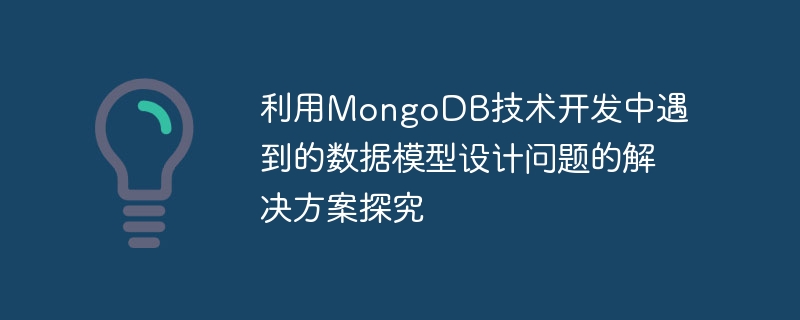Research on solutions to data model design problems encountered in MongoDB technology development
- 王林Original
- 2023-10-09 19:50:021256browse

Exploring solutions to data model design problems encountered in the development of MongoDB technology
Abstract: With the advent of the big data era, the NoSQL database MongoDB is playing a key role in data storage and processing advantages were gradually discovered and applied. However, in practical applications, the data model needs to be reasonably designed to avoid performance degradation and low query efficiency. This article will combine actual cases to discuss data model design issues commonly encountered in development using MongoDB technology, and provide some solutions and specific code examples.
- Introduction
MongoDB is a database that uses distributed storage and is document-oriented, with high performance, scalability and powerful query capabilities. However, in actual development, the design of the data model is a very critical step. An unreasonable data model will lead to problems such as low query efficiency, redundant data, and performance degradation. This article will discuss solutions to common data model design problems. - Data model design issues and solutions
2.1 Redundant data
Redundant data means that the same data information is stored in different documents. In some cases, redundant data can improve query efficiency, but too much redundant data can cause data consistency issues and extra storage space. The solution is to use reference relationships, store redundant data in separate documents and query it when needed.
Sample code:
// 存储用户信息的文档
{
"userId": "123456",
"username": "John",
"email": "john@example.com"
}
// 存储订单信息的文档,使用引用关系存储用户信息
{
"orderId": "789012",
"userId": "123456",
"product": "Apple",
"price": 10
}In the above code, the userId field in the order information is associated with the document that stores the user information using a reference relationship. When querying the order When requesting information, you can obtain the corresponding user information based on the userId field.
2.2 Nested documents too deep
MongoDB supports the storage of nested documents, but when the nested documents are too deep, it will cause query and update operations to be complex and inefficient. The solution is to split the nested documents into separate documents and relate them using reference relationships.
Sample code:
// 存储订单信息的文档
{
"orderId": "789012",
"userId": "123456",
"products": [
{
"name": "Apple",
"price": 10
},
{
"name": "Banana",
"price": 5
}
]
}
// 拆分嵌套文档后的订单信息和产品信息
// 存储订单信息的文档
{
"orderId": "789012",
"userId": "123456",
"products": ["product1Id", "product2Id"]
}
// 存储产品信息的文档
{
"productId": "product1Id",
"name": "Apple",
"price": 10
}
{
"productId": "product2Id",
"name": "Banana",
"price": 5
}In the above code, the product information originally nested in the order information is split into separate documents and related using reference relationships. When querying the order information, you can Get detailed product information by product ID.
2.3 Many-to-many relationship
In some scenarios, you will encounter data model design issues for many-to-many relationships, such as the relationship between users and tags. MongoDB can use arrays to store associated data IDs to solve this problem.
Sample code:
// 存储用户信息的文档
{
"userId": "123456",
"username": "John",
"email": "john@example.com",
"tagIds": ["tag1Id", "tag2Id"]
}
// 存储标签信息的文档
{
"tagId": "tag1Id",
"tagName": "Sports"
}
{
"tagId": "tag2Id",
"tagName": "Music"
}In the above code, the tagIds field in the user information is an array that stores tag IDs. The tag ID in the array is combined with the stored tag Information documents are associated.
- Conclusion
When developing using MongoDB technology, reasonable data model design is the key to ensuring application performance. This article demonstrates some reasonable data model designs and specific code examples by exploring solutions to common problems such as redundant data, too deep nested documents, and many-to-many relationships. By following these design principles, you can make full use of its powerful query capabilities and advantages in MongoDB, improving application performance and development efficiency.
References:
[1] MongoDB official documentation. https://docs.mongodb.com/
[2] P. Wilson, N. Antonopoulos. "MongoDB and Python: Patterns and Processes for the Popular Document-Oriented Database". Packt Publishing Ltd, 2011.
The above is the detailed content of Research on solutions to data model design problems encountered in MongoDB technology development. For more information, please follow other related articles on the PHP Chinese website!

